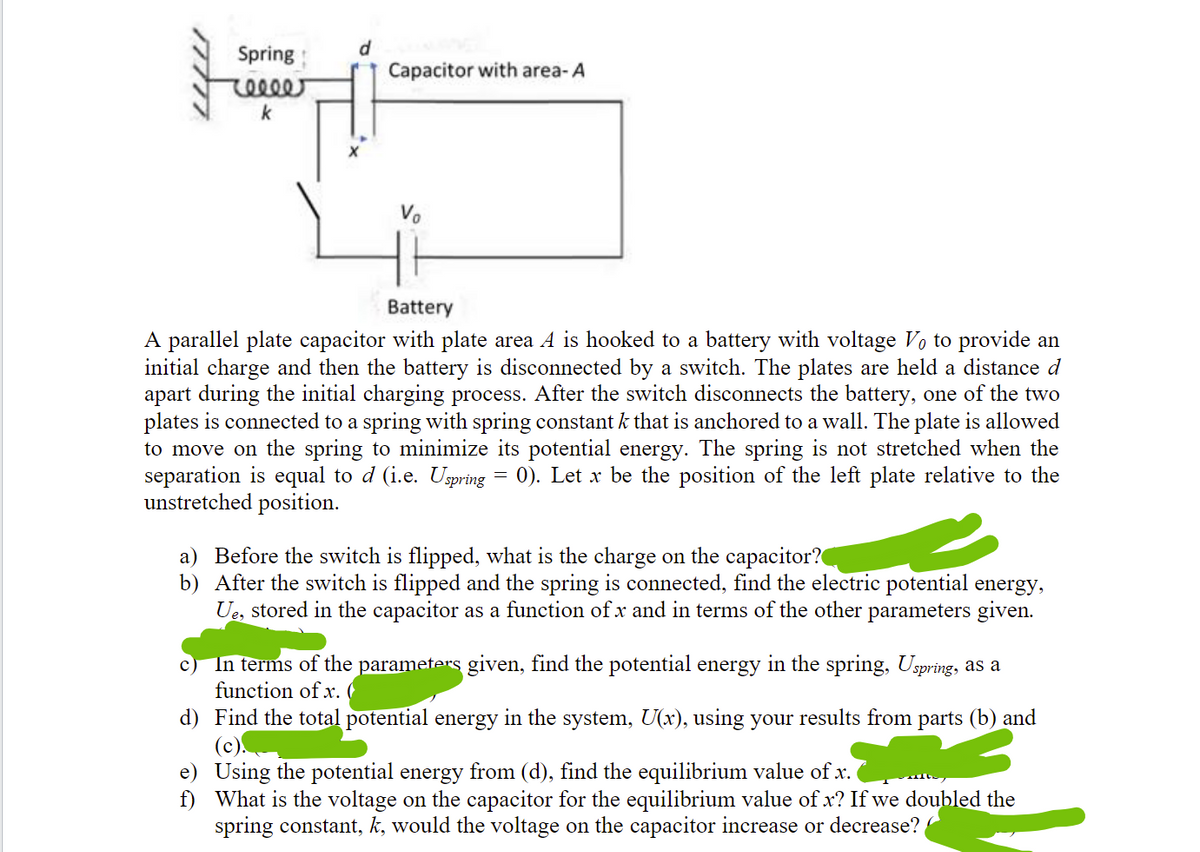Spring reeeer k Capacitor with area- A с Vo Battery A parallel plate capacitor with plate area A is hooked to a battery with voltage Vo to provide an initial charge and then the battery is disconnected by a switch. The plates are held a distance d apart during the initial charging process. After the switch disconnects the battery, one of the two plates is connected to a spring with spring constant k that is anchored to a wall. The plate is allowed to move on the spring to minimize its potential energy. The spring is not stretched when the separation is equal to d (i.e. Uspring = 0). Let x be the position of the left plate relative to the unstretched position. a) Before the switch is flipped, what is the charge on the capacitor? b) After the switch is flipped and the spring is connected, find the electric potential energy, Ue, stored in the capacitor as a function of x and in terms of the other parameters given. In terms of the parameters given, find the potential energy in the spring, Uspring, as a function of x. ( d) Find the total potential energy in the system, U(x), using your results from parts (b) and (c). e) Using the potential energy from (d), find the equilibrium value of x. f) What is the voltage on the capacitor for the equilibrium value of x? If we doubled the spring constant, k, would the voltage on the capacitor increase or decrease?
Spring reeeer k Capacitor with area- A с Vo Battery A parallel plate capacitor with plate area A is hooked to a battery with voltage Vo to provide an initial charge and then the battery is disconnected by a switch. The plates are held a distance d apart during the initial charging process. After the switch disconnects the battery, one of the two plates is connected to a spring with spring constant k that is anchored to a wall. The plate is allowed to move on the spring to minimize its potential energy. The spring is not stretched when the separation is equal to d (i.e. Uspring = 0). Let x be the position of the left plate relative to the unstretched position. a) Before the switch is flipped, what is the charge on the capacitor? b) After the switch is flipped and the spring is connected, find the electric potential energy, Ue, stored in the capacitor as a function of x and in terms of the other parameters given. In terms of the parameters given, find the potential energy in the spring, Uspring, as a function of x. ( d) Find the total potential energy in the system, U(x), using your results from parts (b) and (c). e) Using the potential energy from (d), find the equilibrium value of x. f) What is the voltage on the capacitor for the equilibrium value of x? If we doubled the spring constant, k, would the voltage on the capacitor increase or decrease?
Related questions
Question
100%
Plz solve this, even if you get some part wrong i vll still upvote, provide handwritten or typed solution..

Transcribed Image Text:Spring
reeeer
k
Capacitor with area- A
V₂
Battery
A parallel plate capacitor with plate area A is hooked to a battery with voltage Vo to provide an
initial charge and then the battery is disconnected by a switch. The plates are held a distance d
apart during the initial charging process. After the switch disconnects the battery, one of the two
plates is connected to a spring with spring constant k that is anchored to a wall. The plate is allowed
to move on the spring to minimize its potential energy. The spring is not stretched when the
separation is equal to d (i.e. Uspring = 0). Let x be the position of the left plate relative to the
unstretched position.
a) Before the switch is flipped, what is the charge on the capacitor?
b) After the switch is flipped and the spring is connected, find the electric potential energy,
Ue, stored in the capacitor as a function of x and in terms of the other parameters given.
c) In terms of the parameters given, find the potential energy in the spring, Uspring, as a
function of x. (
d) Find the total potential energy in the system, U(x), using your results from parts (b) and
(c)
e) Using the potential energy from (d), find the equilibrium value of x.
f) What is the voltage on the capacitor for the equilibrium value of x? If we doubled the
spring constant, k, would the voltage on the capacitor increase or decrease?
Expert Solution
This question has been solved!
Explore an expertly crafted, step-by-step solution for a thorough understanding of key concepts.
Step by step
Solved in 2 steps with 2 images
